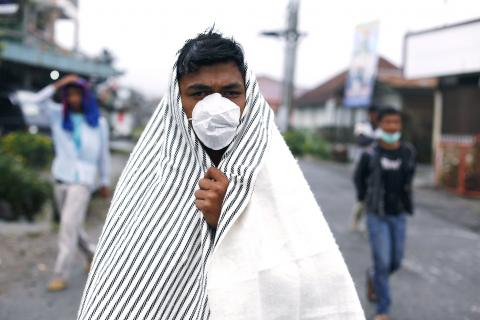An Indonesian volcano that was quiet for four centuries shot a new, powerful burst of hot ash more than 3km in the air yesterday, sending frightened residents fleeing to safety for the second time this week.
The tremor from the eruption — the strongest so far — could be felt 8km away.
“This was a big one!” said 37-year-old Anto Sembiring, who abandoned his coffee shop not far from the crater’s mouth to join hundreds of others near Mount Sinabung’s base. “We all ran as fast as we could ... Everyone was panicking.”

PHOTO: REUTERS
The eruption of Mount Sinabung on Sunday and Monday — which caught many scientists off guard — forced 30,000 people living along its fertile slopes in North Sumatra province to evacuate to cramped emergency shelters in nearby towns.
Many started returning to their mountainside homes as activity started to wane, saying they wanted to tend to their vegetable farms and rice fields and to reopen small businesses.
A new alert was issued several hours before yesterday’s blast.
Some people trudged back down the slopes, carrying blankets, clothes and food, but others insisted on staying, even after the new explosion, which caused the entire mountain to shake for five minutes.
“We’re not going anywhere,” said Razia Barimbing, who was among 50 men refusing to budge, saying they had to protect abandoned villages a few kilometers from the crater’s mouth against looters.
“It’s so sad to see this,” said the 35-year-old farmer, pointing to the white dust blanketing houses, gardens and even livestock. “We just want this to be over, so we can pull our lives back together, and get our children back in school.”
The air was thick with the smell of sulfur and, despite a soft drizzle, heavy smoke limited visibility to just a few meters.
Some small domestic hopper flights had to be diverted, said Bambang Ervan, the transportation ministry’s spokesman.
International air travel was unaffected.
Mount Sinabung had last erupted in 1600, and government volcanologists acknowledged they had made no efforts before the mountain started rumbling last week to sample gases or look out for rising magma or other signs of seismic activity.
They were too busy with more than 129 active volcanoes in Indonesia, a seismically charged region because of its location on the “Ring of Fire” — a series of fault lines stretching from the Western Hemisphere through Japan and Southeast Asia.
They said from now on they would be watching it very closely.
“It’s still going off, even now,” said Surono, who heads the nation’s volcano alert center. “You can’t see it because of the heavy fog around the crater, but according to our seismic recorder, there are still small eruptions.”
There are fears that current activity could foreshadow a much more destructive explosion in a few weeks or months, though it is possible, too, that the mountain will go back to sleep after letting off steam.

Former Nicaraguan president Violeta Chamorro, who brought peace to Nicaragua after years of war and was the first woman elected president in the Americas, died on Saturday at the age of 95, her family said. Chamorro, who ruled the poor Central American country from 1990 to 1997, “died in peace, surrounded by the affection and love of her children,” said a statement issued by her four children. As president, Chamorro ended a civil war that had raged for much of the 1980s as US-backed rebels known as the “Contras” fought the leftist Sandinista government. That conflict made Nicaragua one of

COMPETITION: The US and Russia make up about 90 percent of the world stockpile and are adding new versions, while China’s nuclear force is steadily rising, SIPRI said Most of the world’s nuclear-armed states continued to modernize their arsenals last year, setting the stage for a new nuclear arms race, the Stockholm International Peace Research Institute (SIPRI) said yesterday. Nuclear powers including the US and Russia — which account for about 90 percent of the world’s stockpile — had spent time last year “upgrading existing weapons and adding newer versions,” researchers said. Since the end of the Cold War, old warheads have generally been dismantled quicker than new ones have been deployed, resulting in a decrease in the overall number of warheads. However, SIPRI said that the trend was likely

BOMBARDMENT: Moscow sent more than 440 drones and 32 missiles, Volodymyr Zelenskiy said, in ‘one of the most terrifying strikes’ on the capital in recent months A nighttime Russian missile and drone bombardment of Ukraine killed at least 15 people and injured 116 while they slept in their homes, local officials said yesterday, with the main barrage centering on the capital, Kyiv. Kyiv City Military Administration head Tymur Tkachenko said 14 people were killed and 99 were injured as explosions echoed across the city for hours during the night. The bombardment demolished a nine-story residential building, destroying dozens of apartments. Emergency workers were at the scene to rescue people from under the rubble. Russia flung more than 440 drones and 32 missiles at Ukraine, Ukrainian President Volodymyr Zelenskiy

Indonesia’s Mount Lewotobi Laki-Laki yesterday erupted again with giant ash and smoke plumes after forcing evacuations of villages and flight cancelations, including to and from the resort island of Bali. Several eruptions sent ash up to 5km into the sky on Tuesday evening to yesterday afternoon. An eruption on Tuesday afternoon sent thick, gray clouds 10km into the sky that expanded into a mushroom-shaped ash cloud visible as much as 150km kilometers away. The eruption alert was raised on Tuesday to the highest level and the danger zone where people are recommended to leave was expanded to 8km from the crater. Officers also